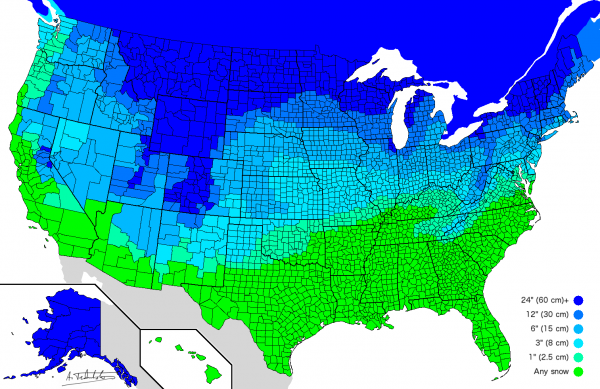Want a Snow Day off from School? It Takes Less Snow in Southern CT
/
The forecast calls for snow Sunday night into Monday morning, and with it comes the possibility of school cancellations. Whether or not students receive a snow day – in Connecticut and across the country – has everything to do with where they live, more than the depth of the snowfall.
Connecticut, more than many states, seems to have varying standards across the state, if data recently published by the website flowingdata.com , based on a nationwide map developed using county-by-county data, is to be believed.
, based on a nationwide map developed using county-by-county data, is to be believed.
The data indicates how much snow, on average, it takes to close schools across the country. Not surprisingly, in the northern states it takes quite a bit, while in the southern U.S. even the slightest snowfall can keep school children home.
In Connecticut, however, there appears to a less than uniform standard. In the states’ southernmost counties – including Fairfield, New Haven, Middlesex and New London - it generally takes 3 - 6 inches of snow to close schools. In the counties across the upper tier of the state – including Litchfield, Hartford, and Tolland, it takes 6 to 12 inches.
Windham Country, in the northeastern corner of the state, tends more toward the 3-6 inch line of demarcation. State law in Connecticut requires at least 180 school days per year, but individual districts—including those experiencing identical weather—often have vastly different ways of accommodating cancellations within the academic calendar. A morning review of the school closing list on any of the major television stations demonstrates the inconsistencies beyond doubt.
The data does not account for ice storms and other winter conditions that can impact when local school superintendents decide to postpone a day’s school. The data also does not reflect early dismissals or delayed arrivals due to weather conditions.
Across the nation, in much of the Midwest and Great Plains, school closing often depends more on wind chill and temperature than on snow accumulation. It has also been pointed out that school closures tend to say more about an area's infrastructure than the toughness of its citizens. The recent impact on Atlanta and other Southern cities when hit with a relatively modest storm reflected that reality.
According to the Connecticut Department of Energy and Environmental Protection, the month of March brings, on average, 4.2 inches of liquid precipitation and 9.3 inches of snowfall. In 1994, however, a record 83.1 inches of snow fell, the most since record-keeping began in 1905.

The map was developed by Alexandr Trubetskoy.






























